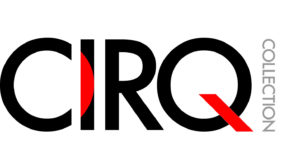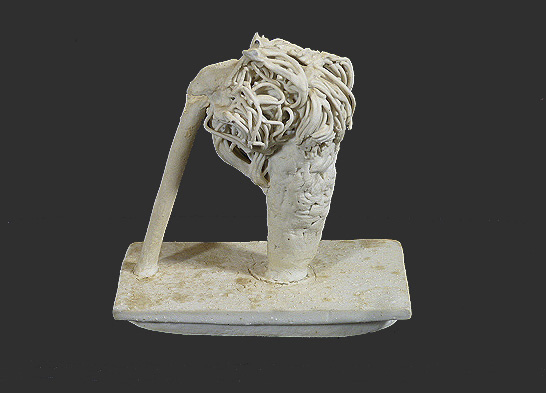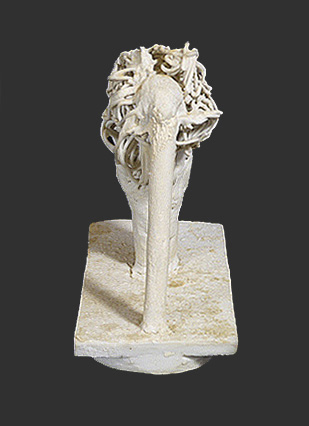| . |
Jan Oosterman’s first training was in garden design and painting. During the second world war he made preparations for the establishment of a ceramic studio for useful ware, which got under way in Hilversum in 1945. After it closed in 1949 he devoted himself to the making of unique pieces, under the inspiration of ceramics by Dirk Hubers.
The period of the unique pieces can be divided into two phases. In the first, which runs from 1950 to 1967, Oosterman made vases and dishes in high fired earthenware, along with monumental tile pictures and, in the years 1963-1968, glass (windows, a font).
Up to 1960 the pots mostly bore incised decoration. Spectacular examples are the large vase forms, sometimes fashioned by Anne Weitjens-Rosendahl (Jan’s wife), and the tile pictures decorated in the so-called ‘glaze-sgraffito’ technique, whereby lines are incised in three successive layers of glaze.
Towards 1960 the vases became smaller and the decoration, now often applied with the brush, much more sober.
The second phase began around 1967, when Jan Oosterman started to experiment with free forms and other ceramic materials. From then onwards he worked with stoneware clay and from 1973 onwards with porcelain as well. A certain degree of alienation is noticeable in many works of this period, for example, in the wall dishes in which doll elements are incorporated. In the very productive seventies numerous sculptures were made: globular forms ceramics ‘leaves’, ‘books’ and ‘blocks of stone’. In these Jan Oosterman achieves a great harmony between the clay, the form and the painted decoration, now mostly consisting of landscape elements, human and animal figures, bicycles, helicopters an texts. A certain atmosphere or feeling is evoked in them. This work stands at the beginning of ceramic landscape sculpture in the Netherlands.
Since 1976 Jan and Anne Oosterman have lived in Rousset-les-vignes in the South of France. There they are continuing their work but using different kinds of clay and kilns (gas and wood).
After years of residence in France, the Oosterman couple returned to the Netherlands in 1987. Jan immediately starts a new period. The motif of the surrounding nature, pollard willow cows, is captured on ceramics in an almost impressionistic way. The porcelain slabs from the Montaillou series are continued in slabs with abstract images in delicate brown and blue tones with a glazed edge as if it were a painting in passé-partout. Heavily painted standing surfaces and blocks are also created with dark, heavily accentuated representations of groups of people in an almost prehistoric brushwork. A radical illness strikes Jan Oosterman at the end of 1990. During a miraculous recovery Jan starts working hard again. At first he works on a number of paintings on paper with intense, bright colors. Ceramics will follow shortly thereafter. This last phase unites the work in optima forma.
Jan Oosterman’s work is exceptional in that it combines ceramics and painting in a very skilful and sensitive way. A survey of his ceramic oeuvre leads to the conclusion that he can be regarded as one of the great modern ceramics.
Works by Oosterman are included in the collections of the Stedelijk Museum, Amsterdam; Museum Boymans-van Beuningen, Rotterdam; Centraal Museum, Utrecht; Museum Het Princessehof, Leeuwarden, Haags Gemeentemuseum, Stedelijk Museum Schiedam and Hetjens Museum in Düsseldorf.
Bron:
. Jan Oosterman ‘een overzicht van zijn keramisch werk’ Stichting Keramisch Werkcentrum Heusden, 1980
. Jan Oosterman, 50 jaar keramiek, 1992
|



